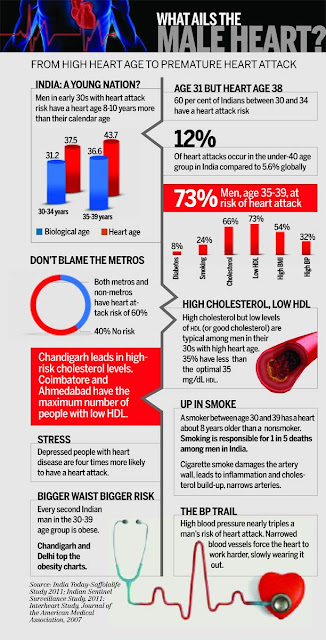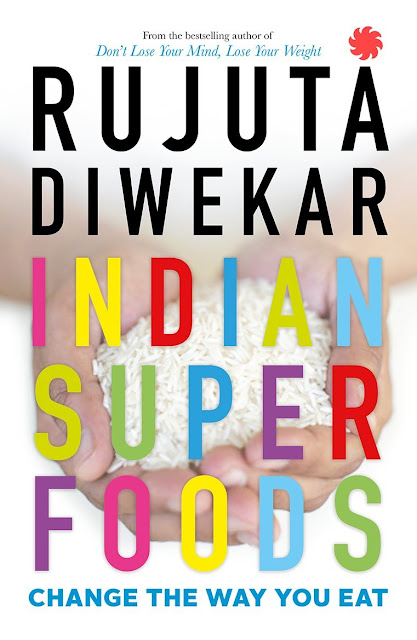Research Post : Men at risk, India tops the world in heart attacks among 35 plus men... Common perception vs Reality
Dated : 10-JUL-2013
 Source : India Today
Source : India TodayThe India Today-Saffolalife Study 2011 on 46,000 urban Indians shows that 78 per cent of men between 30 and 34 run the risk of a heart attack. And their hearts are ageing faster than their real age.
Here are the common perceptions that the study blows apart:
Your biological age is the same as your heart age
REALITY "Calendar age has little to do with organ function.
People remain much younger than their birth age if they look after themselves," says Dr Prashant Joshi of Government Medical College, Nagpur, who led the Indian chapter of the interheart study. "The risk factors affect blood vessels, which in turn affect the heart. The 17th century physician Thomas Sydenham had once famously said, you are as old as your arteries," he adds. "Changing one's lifestyle is very difficult. Knowing the heart age can motivate people to adopt a healthy lifestyle."
Indians are genetically vulnerable to heart diseases
REALITY "Yes and no," says Dr Trehan.
"If both your parents have coronary artery disease, it ups your chances four-fold. But environment and lifestyle have a huge role to play, he explains. Even with no family history, one may get a heart attack at a younger age. "Especially, if you are obese, have problems with blood fat levels and are a sedentary smoker," he adds.
The standard theory is: so-called "thrifty genes" developed in Indians over billions of years of evolution to survive drought and famine in the subcontinent metabolise food lowly and conserve as much fat and carbohydrate as possible. But at a time when scarcity is no longer the issue, the genes continue to work. The outcome? A dysfunctional biochemical profile.
The interheart study, conducted on 26,000 people for five years (and published in the Journal of the American Medical Association in 2007), first burst the theory. "It was found that factors that explain heart attacks in the rest of the world held true for Indians, too," says Dr Prem Pais, dean of St John's Medical College, Bangalore, and one of the research members involved in the study. "Nearly 86 per cent of heart attacks in India can be explained by the same risk factors in other parts of the world," Pais points out.
Culture of vegetarianism protects against heart attacks in India
REALITY Not true.
"Indian diet is rich in saturated fats and very high in levels of refined carbohydrates," says Dr D. Prabhakaran, executive director of Centre for Chronic Disease Control in Delhi. "We consume fruits and vegetables at half the rate prevalent in other countries. And the mode of prolonged cooking we follow destroys 90 per cent of the protective vitamins, folate." According to the india today-Saffolalife study 2011, 34 per cent of Indians don't eat even a single fruit a day. "Lifestyle changes associated with new urbanisation are linked to this dietary pattern," says Prabhakaran. Heart disease is known to grow with rising per capita income.
High levels of bad cholesterol, LDL, are crucial in heart disease
REALITY No.
 In India, it's low levels of the 'good cholesterol' HDL. Dr Reddy says, "At any given level of cholesterol, the ratio of total cholesterol to HDL is higher in Indians." (High total cholesterol to hdl ratio indicates high risk of heart attacks.) The level of all the artery-clogging 'bad' lipids circulating in blood, what we call non-hdl cholesterol, is also higher among Indians, predicting risk. The type of 'bad cholesterol' ldl Indians have is different, he explains. The proportion of the more dangerous small dense ldl is higher in Indians. "For any given level of total cholesterol, the clot-forming tendency of lipids is much higher. So even at cholesterol level of 180-190, we seem to be at a much greater risk than the western population," he says.
In India, it's low levels of the 'good cholesterol' HDL. Dr Reddy says, "At any given level of cholesterol, the ratio of total cholesterol to HDL is higher in Indians." (High total cholesterol to hdl ratio indicates high risk of heart attacks.) The level of all the artery-clogging 'bad' lipids circulating in blood, what we call non-hdl cholesterol, is also higher among Indians, predicting risk. The type of 'bad cholesterol' ldl Indians have is different, he explains. The proportion of the more dangerous small dense ldl is higher in Indians. "For any given level of total cholesterol, the clot-forming tendency of lipids is much higher. So even at cholesterol level of 180-190, we seem to be at a much greater risk than the western population," he says.Reddy warns against focusing only on total cholesterol during screenings. "Many doctors don't look at total cholesterol to hdl ratio or small dense ldl cholesterol levels," Reddy adds. Even with 180 mg of cholesterol, one could have a poor total cholesterol-hdl ratio and therefore be at risk. Moreover, if one is a smoker with high to normal levels of blood sugar and pressure, then even a borderline cholesterol level of 200 mg/dL, would put one at high risk.
Metro males are at a greater risk than their non-metro counterparts
REALITY Cardiovascular disease started among the more affluent sections of society, says Dr Prabhakaran. "But it is now advancing toward the middle and lower middle classes, those with less information and awareness." While early adopters of new lifestyles, initially at higher risk, lowered their risk factors as knowledge spread, the ones who adapted to it later got stuck. "In some states like Kerala and Tamil Nadu, which are far advanced in the epidemiological transition-the health transition in tandem with economic progress-the non-metro and rural locations have almost the same burden of heart disease as metros."
Heart attack risk cannot be reversed
REALITY They can certainly be reversed to a large extent, says Dr Panda.
There are two types of risk factors, he explains. One is where the risk of a heart attack can be reversed through change in lifestyle like smoking, exercise, obesity, diet rich in cholesterol, stress, diabetes and hypertension. Age, gender and a family history of heart disease belong to the other category of risk factors that cannot be modified. "Controlling the modifiable risk factors along with regular health checkups can help prevent heart disease," he adds.
It is not possible to predict heart attacks with certainty
REALITY That was true 10 years ago.
But with modern diagnostic tools and tests available across the country now, heart attacks can be predicted with over 90 per cent accuracy. Dr Trehan lists some of the tests that can indicate one's risk: from clinical examination and estimation of body mass index to testing biochemical parameters like blood sugar, lipid profile, high-sensitivity CRP in blood, stress testing, measuring carotid IMT and arterial stiffness to CT coronary angiograms.
"If the advanced CT scanners show that arterial walls are clean it is very unlikely that you will develop heart attack," points out Dr Shetty. But if they show that the arterial wall is thickened and there is some blockage, one would be at risk of developing heart attack. "Every Indian past the age of 30 must undergo a 64-slice ct scan every few years," he adds.
There's a message for the young: make an early start. When the fhs started in the 1950s the US was facing a growing burden of heart disease, a situation that India is facing now. Deaths from heart disease, India's leading cause of mortality, have spiralled by 18 per cent in less than two decades. A loss of 17.9 million productive years of life by 2030 stares Indians in the face. The computation of heart age according to fhs, as Dr Joshi points out, does not take into account several crucial heart risk factors-from physical activity, intake of fruits and vegetables, diet, chewed tobacco to psychosocial stress. But with the epidemic raging out of control, any tool to knock out a killer enemy is welcome.
Read full article at : http://indiatoday.intoday.in/story/india-tops-the-world-in-heart-attacks-among-35-plus-men/1/154103.html


Comments
Post a Comment